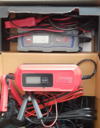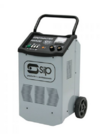CAUTION
If the completely discharged battery is connected directly in parallel to a battery that has some charge the current flow will not be limited and could be high enough to cause one or both off the batteries to suffer significant damage.
Sometimes it is safer to avoid the use of an "intelligent" automatic battery charger.
Many years ago I considered this with lead acid, I must say this is lead acid not any other type, and I worried about when the split charging relay energised with a leisure battery and prime mover battery in parallel, however the only time any significant current flows is when one cell has gone short circuit. Even a battery showing zero volts, connected to a fully charged battery, the current is not very high.
I have done this many times with a fuse (25 amp) in the connecting lead, and it has never blown.
an "intelligent" automatic battery charger
Will not charge a completely discharged battery. Even the single voltage chargers like the Ctek MXS range with no volt meter or ability to charge 6 volt batteries will not start to charge if under 2 volt, the better chargers with built in volt meters and auto 6 volt switching, need 7.4 volt with 12 volt battery and 3.7 volt with a 6 volt battery to start charging.
I found a pair of 7 Ah batteries which had been completely discharged on a stair lift, and could not be charged unless the lift was parked at either end, it was stuck mid way, so had to fit a pair of new to get stair lift to one end, no manual winder on it. The pair of good but discharged batteries went missing, and it was only when my father-in-law died I found them.
I assumed they were now useless, however I put one in parallel with a good one, and put it on charge with the Lidi charger, plugged into an energy monitor, so I could from my lap top see what was going on.
It charged the donor battery then switched to stand-by mode in essence off, and sat there for nearly two weeks, then as if some one had flicked a switch, it started to charge and went through the complete charging cycle, I used the battery to power my ham radio, and it behaved like a new battery, seemed no worse for being left so long discharged, so repeated with second battery of the pair with same results. Also did same with jump starter unit, and two caravan leisure batteries, the last one was a failure, but 4 or the 5 batteries recovered.
I would not attempt this with a Ni/Iron battery, but with lead acid there seems to be no problem.
However did have a problem with mobility scooter batteries, I tested before leaving home, 150 watt inverter with the battery charger pulled in seemed to work, so great could charge while on holiday, however once discharged the charger tripped the inverter on over current, real pain as can't charge the batteries off the scooter, so had to get whole scooter into hotel room to recharge batteries. Back then you didn't get EV charging points at hotels. That would be worth a picture to see a mobility scooter charging from an EV point, must be possible as the Citroen Ami only has a 16 amp lead with standard Schuko or 13 amp plug.




